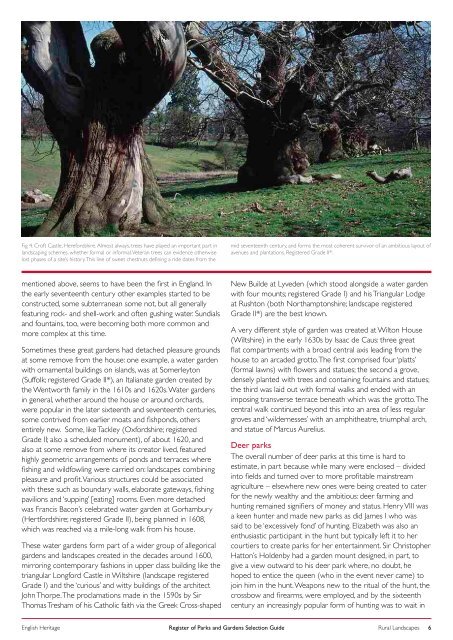Rural Landscapes - English Heritage
Rural Landscapes - English Heritage
Rural Landscapes - English Heritage
Create successful ePaper yourself
Turn your PDF publications into a flip-book with our unique Google optimized e-Paper software.
Fig 4. Croft Castle, Herefordshire. Almost always, trees have played an important part in<br />
landscaping schemes, whether formal or informal. Veteran trees can evidence otherwise<br />
lost phases of a site’s history. This line of sweet chestnuts defining a ride dates from the<br />
mid seventeenth century, and forms the most coherent survivor of an ambitious layout of<br />
avenues and plantations. Registered Grade II*.<br />
mentioned above, seems to have been the first in England. In<br />
the early seventeenth century other examples started to be<br />
constructed, some subterranean some not, but all generally<br />
featuring rock- and shell-work and often gushing water. Sundials<br />
and fountains, too, were becoming both more common and<br />
more complex at this time.<br />
Sometimes these great gardens had detached pleasure grounds<br />
at some remove from the house: one example, a water garden<br />
with ornamental buildings on islands, was at Somerleyton<br />
(Suffolk; registered Grade II*), an Italianate garden created by<br />
the Wentworth family in the 1610s and 1620s. Water gardens<br />
in general, whether around the house or around orchards,<br />
were popular in the later sixteenth and seventeenth centuries,<br />
some contrived from earlier moats and fishponds, others<br />
entirely new. Some, like Tackley (Oxfordshire; registered<br />
Grade II; also a scheduled monument), of about 1620, and<br />
also at some remove from where its creator lived, featured<br />
highly geometric arrangements of ponds and terraces where<br />
fishing and wildfowling were carried on: landscapes combining<br />
pleasure and profit. Various structures could be associated<br />
with these such as boundary walls, elaborate gateways, fishing<br />
pavilions and ‘supping’ [eating] rooms. Even more detached<br />
was Francis Bacon’s celebrated water garden at Gorhambury<br />
(Hertfordshire; registered Grade II), being planned in 1608,<br />
which was reached via a mile-long walk from his house.<br />
These water gardens form part of a wider group of allegorical<br />
gardens and landscapes created in the decades around 1600,<br />
mirroring contemporary fashions in upper class building like the<br />
triangular Longford Castle in Wiltshire (landscape registered<br />
Grade I) and the ‘curious’ and witty buildings of the architect<br />
John Thorpe. The proclamations made in the 1590s by Sir<br />
Thomas Tresham of his Catholic faith via the Greek Cross-shaped<br />
New Builde at Lyveden (which stood alongside a water garden<br />
with four mounts; registered Grade I) and his Triangular Lodge<br />
at Rushton (both Northamptonshire; landscape registered<br />
Grade II*) are the best known.<br />
A very different style of garden was created at Wilton House<br />
(Wiltshire) in the early 1630s by Isaac de Caus: three great<br />
flat compartments with a broad central axis leading from the<br />
house to an arcaded grotto. The first comprised four ‘platts’<br />
(formal lawns) with flowers and statues; the second a grove,<br />
densely planted with trees and containing fountains and statues;<br />
the third was laid out with formal walks and ended with an<br />
imposing transverse terrace beneath which was the grotto. The<br />
central walk continued beyond this into an area of less regular<br />
groves and ‘wildernesses’ with an amphitheatre, triumphal arch,<br />
and statue of Marcus Aurelius.<br />
Deer parks<br />
The overall number of deer parks at this time is hard to<br />
estimate, in part because while many were enclosed – divided<br />
into fields and turned over to more profitable mainstream<br />
agriculture – elsewhere new ones were being created to cater<br />
for the newly wealthy and the ambitious: deer farming and<br />
hunting remained signifiers of money and status. Henry VIII was<br />
a keen hunter and made new parks as did James I who was<br />
said to be ‘excessively fond’ of hunting. Elizabeth was also an<br />
enthusiastic participant in the hunt but typically left it to her<br />
courtiers to create parks for her entertainment. Sir Christopher<br />
Hatton’s Holdenby had a garden mount designed, in part, to<br />
give a view outward to his deer park where, no doubt, he<br />
hoped to entice the queen (who in the event never came) to<br />
join him in the hunt. Weapons new to the ritual of the hunt, the<br />
crossbow and firearms, were employed, and by the sixteenth<br />
century an increasingly popular form of hunting was to wait in<br />
<strong>English</strong> <strong>Heritage</strong> Register of Parks and Gardens Selection Guide<br />
<strong>Rural</strong> <strong>Landscapes</strong> 6
















